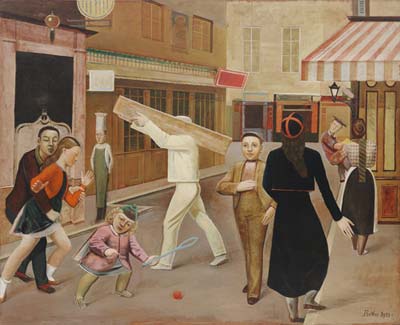pipeline
And let all the tondo gang bola
{ Dan Deacon on NBC morning | Thanks Brad! }
‘If everything seems under control, you’re just not going fast enough.’ –Mario Andretti
“The dinner went well. The guest of honor didn’t sneeze. We were lucky.”
This comment was heard after a dinner at the U.S. State Department, where senior administration officials hosted a dinner for a delegation beginning a week of high-level meetings. The guest that didn’t sneeze was the senior person, allergic to flowers. Even though there were flowers on the tables, there were no sneezes.
It wasn’t luck that the guest was comfortable. Research by the protocol staff had discovered the allergy and found flowers that wouldn’t cause a problem. Thanks to the staff’s work, no headlines appeared announcing that dinner at the Department of State made a visiting dignitary sick.
At first, reading this story seems to confirm the stereotype that protocol and the work of protocol officers is simply about flowers, menus and seating plans. But to focus on those tasks is to miss the purpose that drives these activities. Robert W. Frye, former Chief of Protocol (…) explained it clearly: “protocol is the art of creating a distraction-free environment that facilitates the complete and open exchange of information to resolve issues and build relationships in global business and international diplomacy.”
‘I don’t sleep. I wait.’ –Charlie Sheen
Last summer, the world’s top software-security experts were panicked by the discovery of a drone-like computer virus, radically different from and far more sophisticated than any they’d seen. The race was on to figure out its payload, its purpose, and who was behind it. As the world now knows, the Stuxnet worm appears to have attacked Iran’s nuclear program. And, as Michael Joseph Gross reports, while its source remains something of a mystery, Stuxnet is the new face of 21st-century warfare: invisible, anonymous, and devastating.
The highest endeavour of the mind is to understand things by the third kind of knowledge.

It’s about Professor Daryl Bem and his cheerful case for ESP.
According to “Feeling the Future,” a peer-reviewed paper the APA’s Journal of Personality and Social Psychology will publish this month, Bem has found evidence supporting the existence of precognition. (…)
Responses to Bem’s paper by the scientific community have ranged from arch disdain to frothing rejection. And in a rebuttal—which, uncommonly, is being published in the same issue of JPSP as Bem’s article—another scientist suggests that not only is this study seriously flawed, but it also foregrounds a crisis in psychology itself. (…)
Over seven years, Bem measured what he considers statistically significant results in eight of his nine studies. In the experiment I tried, the average hit rate among 100 Cornell undergraduates for erotic photos was 53.1 percent. (Neutral photos showed no effect.) That doesn’t seem like much, but as Bem points out, it’s about the same as the house’s advantage in roulette. (…)
“It shouldn’t be difficult to do one proper experiment and not nine crappy experiments,” the University of Amsterdam’s Eric-Jan Wagenmakers, co-author of the rebuttal, says. (…)
Before PSI, Bem made his biggest splash in the nonacademic world with a politically incorrect but weirdly compelling theory of sexual orientation. In 1996, he published “Exotic Becomes Erotic” in Psychological Review, arguing that neither gays nor straights are “born that way”—they’re born a certain way, and that’s what eventually determines their sexual preference.
“I think what the genes code for is not sexual orientation but rather a type of personality,” he explains. According to the EBE theory, if your genes make you a traditionally “male” little boy, a lover of sports and sticks, you’ll fit in with other boys, so what will be exotic to you—and, eventually, erotic—are females. On the other hand, if you’re sensitive, flamboyant, performative, you’ll be alienated from other boys, so you’ll gravitate sexually toward your exotic—males.
EBE is not exactly universally accepted.
photos { Irina Werning, Back to the future, Mechi 1990 & 2010, Buenos Aires | more }
Oh I’m so, so sorry

Not only do insincere apologies fail to make amends, they can also cause damage by making us feel angry and distrustful towards those who are trying to trick us into forgiving them.
Even sincere apologies are just the start of the repair process. Although we expect the words “I’m sorry” to do the trick, they don’t do nearly as much as we expect.
photo { Richard Misrach }
‘We are healed of a suffering only by experiencing it to the full.’ –Proust

Jay Traver had begun to notice an uncomfortable crawling sensation under her skin. Scalp spots had bothered her for years but despite her best efforts – she was, after all, a renowned professor of zoology – she couldn’t identify the parasites.
Over the seasons the bugs had spread across her body and eventually invaded her eyes, ears and nostrils, raising her discomfort to fever pitch. Doctors seemed mystified but by the summer of 1950 she had made a breakthrough.
Strong caustic soaps seemed to help control the infestation and she had dug some of the bugs out of her skin with her nails to identify them as dermatophagoides – a mite never previously known to infect humans.
photo { Süleyman Gezgin }
‘Injustice governs the universe. All that is made and all that is unmade therein carries the imprint of a corrupt fragility, as if matter were the fruit of an outrage in the womb of nothingness.’ –Cioran

Piracy is the Future of Television
The convergence of television and the Internet is in its early stages, and the two media will increasingly interconnect over the coming years. A number of services are currently competing to become the dominant protocol for consumption of TV content via the Internet. This paper examines the major services that are currently available for downloading or streaming television programs online, both legal and illegal. We propose that, of the options now available to media users, illegal downloading is the most usable and feature-rich, and bears the greatest potential for pioneering new modes of audience engagement, as well as new global revenue streams, related to television products.
{ Abigail De Kosnik, University of California, Berkeley | PDF | Continue reading }
photo { William Eggleston }
‘Without play, there is no experimentation.’ –Paul Rand

Swedish scientists have explored how a brain identifies its own body and how body image can change by successfully creating the illusion of owning three arms or being the size of a Barbie doll in a laboratory setting.
The research not only addresses some of the oldest philosophical and psychological questions about the relationship between body and mind, but also has potential applications in prosthetics and robotics. (…)
Ongoing projects question whether the perceived body can be shrunk to the size of a Barbie doll or if the brain can accept a body of a different sex.
Other seemingly bizarre recent projects have included giving participants the illusion of shaking hands with themselves, having their stomachs slashed with a kitchen knife and seeing themselves from behind. All were designed to trick participants into a false perception of owning another body.
photo { David Fenton, Nurses on the Sidewalk, Chicano Moratorium, Los Angelos, CA, February 28th, 1970 }
No more singing all the dogs in his sengaggeng

Shanghai is to extend the one-child policy to man’s best friend after tens of thousands of people complained of being bitten last year – and to prevent dog mess spoiling the country’s showcase business city.
The rule has already been imposed in several other Chinese cities, but Shanghai’s size – it has a population of more than 20 million – has made the presence of thousands of dogs more problematic. Dogs bigger than 3ft will be banned from the centre of the city and so-called “attack dogs”, including bulldogs, will be banned completely.
The ruling is the latest instance of uneasy relationships between man’s best friend and the Chinese authorities. During the Communist era of Mao Zedong, pets were frowned upon as a middle-class affectation and government opponents were condemned as capitalist running dogs. But China’s growing openness, combined with its rising affluence, means that pets are making a comeback, and there are around 100 million pet dogs in China. However, from May, a one-dog policy will be introduced in Shanghai and more than 600,000 unlicensed dogs will be declared illegal – and killed because of fears of rabies.
photo { Alvaro Sanchez-Montañes }
related { The special bond that often forms between people and both domesticated and wild animals may be, paradoxically, part of what makes us human. | Seed | full story }
Wendy. Darling. Light of my life. I’m not gonna hurt ya.
Has warfare been handed down to us through millions of years of evolution? Is it part of who we are as a species? At the heart of this question is whether humans have a natural capacity to kill other humans.
Some social scientists have concluded that evolution has in fact left us with this unfortunate ability.
Primatologist Richard Wrangham, a major proponent of this idea, developed the “Imbalance of Power Hypothesis” to explain how evolution could produce a propensity for warfare in humans.
The idea is that our primate ancestors could have gained access to additional food and other resources by attacking and killing their neighbors. Of course, these deadly attacks would have only been worthwhile if the attackers could ensure their own safety. So, Dr. Wrangham reasons, our ancestors would have carried out deadly attacks only when they severely outnumbered their victims. The conclusion is that our ancestors who were psychologically predisposed to cooperatively pick off their neighbors would have had a distinct evolutionary advantage. Or, in Dr. Wrangham’s words, ”there has been selection for a male psyche that, in certain circumstances, seeks opportunities to carry out low-cost attacks on unsuspecting neighbors.”
This trait would have been amplified and passed down through the generations until it was eventually inherited by modern humans, who presumably took this predisposition and ran with it, inventing more and more efficient ways to kill each other.
The “Imbalance of Power Hypothesis” is largely based on evidence of violence in the animal world, particularly observations of violent behavior among chimpanzees, our closest animal relatives.
But other social scientists have instead studied modern humans in an attempt to discover whether warfare is rooted in evolution. And, contrary to the predictions of the “Imbalance of Power Hypothesis,” many of these scientists have concluded that humans have an innate aversion to killing others.
What we have is more sacred than a vow or a ring

Consumers are hoping to cash in on last week’s state Supreme Court ruling that it’s illegal for retailers to ask customers for their ZIP Codes during credit card transactions, except in limited cases.
More than a dozen new lawsuits have been filed against major chains that do business in California, including Wal-Mart Stores Inc., Bed Bath & Beyond Inc., Crate & Barrel and Victoria’s Secret. More filings are expected in the coming weeks.
The flurry of litigation stems from a decision last week against Williams-Sonoma Inc. in which the state high court ruled unanimously that ZIP Codes were “personal identification information” that merchants can’t demand from customers under a California consumer privacy law.
painting { Balthus, The Street, 1933 }
Better signals translate into clearer images
{ In 1900, a German named Wilhelm von Osten displayed to the public his horse, Clever Hans (Kluge Hans), who was apparently able to perform mathematical calculations. | Encyclopedia of Claims, Frauds, and Hoaxes of the Occult and Supernatural | Continue reading }
‘There are so many great thoughts that do nothing more than the bellows: they inflate, and make emptier than ever.’ –Nietzsche

Imagine that someone committed a murder. Now imagine that the murderer risked his own life to save another person. Would you forgive the murderer for his crime?
No?
So, how many lives would the murderer need to save to balance out his original sin?
5?
10?
In one study, the median answer was 25.
This is an example of what psychologists call the negativity bias, which is a powerful part of the human mind.
‘Nobody gets justice. People only get good luck or bad luck.’ –Orson Welles

At its heart, cancer is caused when our genes – the instructions encoded in the DNA found within our cells – go wrong. Without the correct instructions, cells start to multiply out of control, fail to die when damaged, and begin to spread around the body.
Scientists studying the precise nature of these microscopic – yet potentially disastrous – errors have found all kinds of weird and wonderful mistakes. These range from very specific ‘typos’ to large scale rearrangements.
To use an analogy, if the entire DNA of a cell (its genome) is a bit like a recipe book, then some genetic faults are the equivalent of simply changing ‘tomato’ into ‘potato’, while others are akin to ripping whole pages out and shuffling them around.
But recent revolutionary research from scientists in the US and UK has revealed a completely different – and catastrophic – way for DNA to get messed up.
Published in the prestigious journal Cell, this groundbreaking work comes from the Cancer Genome Project team, who brought us the first fully mapped cancer genomes at the end of 2009. Since then they’ve been busy analysing DNA from samples taken from many different types of cancer and trying to spot interesting patterns in the data.
Since the 1970s, the prevailing view has been that cancers ‘evolve’ gradually, picking up a few new faults each time a cell divides. This idea is supported by plenty of research into cancer genomes over the years.
But in their latest investigations, the Cancer Genome team noticed a few examples that bucked this trend. (…)
Within our cells, our DNA is arranged into individual pieces known as chromosomes, and 46 chromosomes are found in virtually all human cells. If the entire DNA of a cell is analogous to an instruction manual, then chromosomes would be individual ‘chapters’.
In a few cancer samples, the scientists found that one or two whole chromosomes had been literally shattered to pieces and stitched back together in a haphazard way – not so much shuffling the pages of the genetic recipe book as completely ripping them to pieces and randomly gluing the bits back together. The researchers call this “chromothripsis” – thripsis being Greek for “shattered into pieces”.
This didn’t seem to be a vanishingly rare event either. Two to three per cent of cancers studied by the team so far show the signs of chromothripsis (across a wide range of different cancer types). And in some cancer types it seemed to be even more common – for example, around a quarter of bone cancer samples had shattered chromosomes.
artwork { Pablo Picasso, Weeping Woman, 1937 }
‘The logic of business is coercion, monopoly, and the destruction of the weak, not ‘choice’ or ’service’ or universal affluence.’ –Thomas Frank

…50-year-old Nobuhiro Komiya who for the last two years has worked tirelessly doing one of the most unlikely and mind boggling of jobs - censoring the unending torrent of hentai manga or pornographic comics which flood Tokyo’s book shops and convenience stores.
“It’s a tough job. (…) It’s totally different to reading manga as a hobby,” he says.
A visit to the Department of Youth Affairs and Public Safety on the 35th floor of Tokyo’s towering Metropolitan Government building, where Komiya and his small team of censors get down to the grisly task of comic book censorship, reveals we are talking about a lot more than the width of Wonder Woman’s bust.
Spread out over the white Formica table-top are the worst of the worst - a hand-picked selection of the weirdest and most shocking examples of hentai from the country which invented it.
“Normal sex doesn’t sell well,” Komiya remarks. School sex, tied-up sex, abnormal sex, sells. So this is what they draw.”
photo { Asha Schechter }








